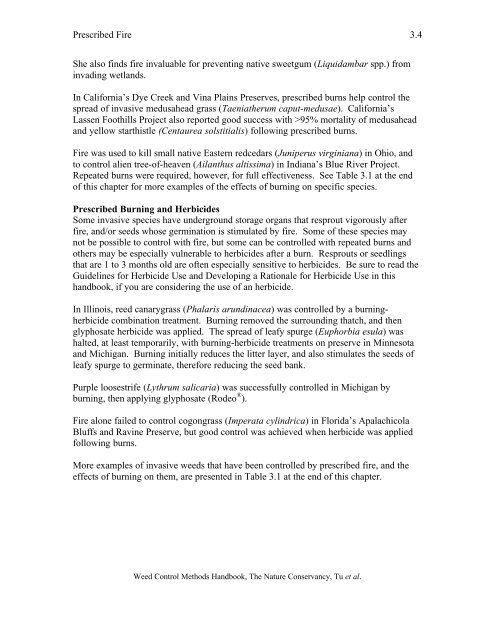Weed Control Methods Handbook: Tools ... - Invasive.org
Weed Control Methods Handbook: Tools ... - Invasive.org
Weed Control Methods Handbook: Tools ... - Invasive.org
You also want an ePaper? Increase the reach of your titles
YUMPU automatically turns print PDFs into web optimized ePapers that Google loves.
Prescribed Fire 3.4<br />
She also finds fire invaluable for preventing native sweetgum (Liquidambar spp.) from<br />
invading wetlands.<br />
In California’s Dye Creek and Vina Plains Preserves, prescribed burns help control the<br />
spread of invasive medusahead grass (Taeniatherum caput-medusae). California’s<br />
Lassen Foothills Project also reported good success with >95% mortality of medusahead<br />
and yellow starthistle (Centaurea solstitialis) following prescribed burns.<br />
Fire was used to kill small native Eastern redcedars (Juniperus virginiana) in Ohio, and<br />
to control alien tree-of-heaven (Ailanthus altissima) in Indiana’s Blue River Project.<br />
Repeated burns were required, however, for full effectiveness. See Table 3.1 at the end<br />
of this chapter for more examples of the effects of burning on specific species.<br />
Prescribed Burning and Herbicides<br />
Some invasive species have underground storage <strong>org</strong>ans that resprout vigorously after<br />
fire, and/or seeds whose germination is stimulated by fire. Some of these species may<br />
not be possible to control with fire, but some can be controlled with repeated burns and<br />
others may be especially vulnerable to herbicides after a burn. Resprouts or seedlings<br />
that are 1 to 3 months old are often especially sensitive to herbicides. Be sure to read the<br />
Guidelines for Herbicide Use and Developing a Rationale for Herbicide Use in this<br />
handbook, if you are considering the use of an herbicide.<br />
In Illinois, reed canarygrass (Phalaris arundinacea) was controlled by a burningherbicide<br />
combination treatment. Burning removed the surrounding thatch, and then<br />
glyphosate herbicide was applied. The spread of leafy spurge (Euphorbia esula) was<br />
halted, at least temporarily, with burning-herbicide treatments on preserve in Minnesota<br />
and Michigan. Burning initially reduces the litter layer, and also stimulates the seeds of<br />
leafy spurge to germinate, therefore reducing the seed bank.<br />
Purple loosestrife (Lythrum salicaria) was successfully controlled in Michigan by<br />
burning, then applying glyphosate (Rodeo ® ).<br />
Fire alone failed to control cogongrass (Imperata cylindrica) in Florida’s Apalachicola<br />
Bluffs and Ravine Preserve, but good control was achieved when herbicide was applied<br />
following burns.<br />
More examples of invasive weeds that have been controlled by prescribed fire, and the<br />
effects of burning on them, are presented in Table 3.1 at the end of this chapter.<br />
<strong>Weed</strong> <strong>Control</strong> <strong>Methods</strong> <strong>Handbook</strong>, The Nature Conservancy, Tu et al.
















